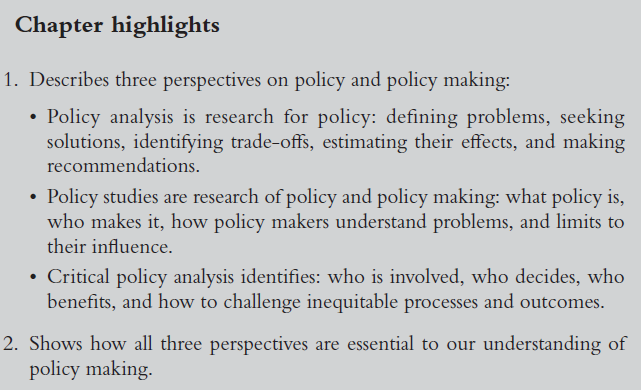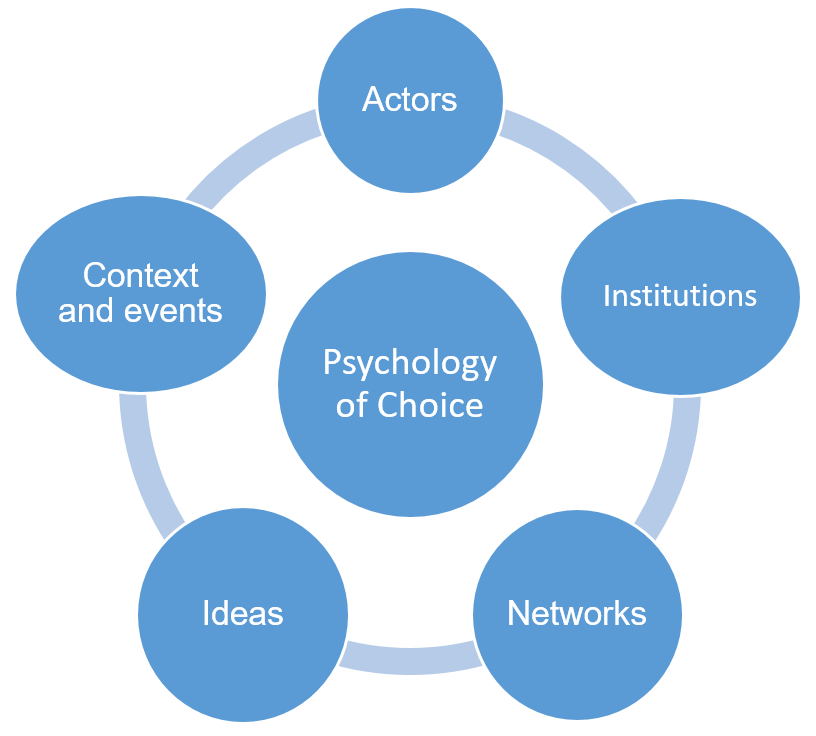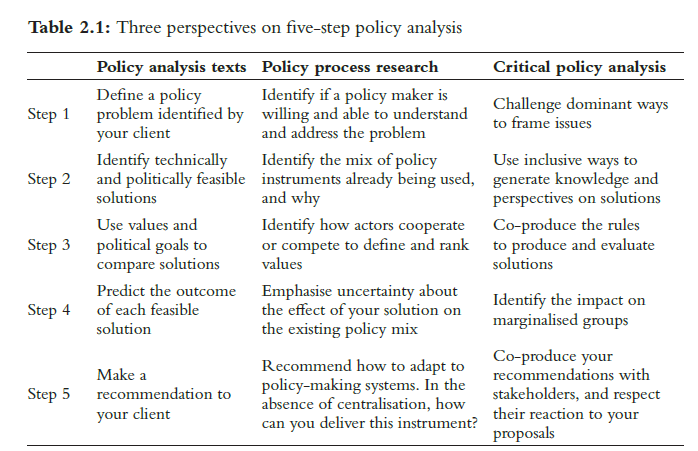This post introduces chapter 2 of Politics and Policy Making in the UK by Paul Cairney and Sean Kippin.
Chapter 2 outlines the structure for UK policy case study analysis, comparing three perspectives: policy analysis, policy studies, and critical policy analysis.

This post summarises Chapter 2 but also signposts a wide range of additional resources on Cairney’s website to aid the study of UK policymaking, including:
- The 750 page which includes a separate book, blog post, and podcast series on the 3 perspectives introduced here.
- The 1000 and 500 pages which include a separate book, blog post, and podcast series on concepts and theories in policy studies.
Key examples of useful preparatory reading include:
Policy in 500 Words: what is public policy and why does it matter?
Policy Concepts in 1000 Words: Policy change and measurement
Policy in 500 Words: how much does policy change?

Using this framework to inform UK studies, connecting chapters 2 and 3
These three perspectives allow us to examine each case study as:
- A policy problem to be addressed. Q: how could analysts and policymakers define and address this problem systematically?
- A way to explore how governments actually work. Q: how did UK policymakers define and address this problem in the real world?
- A way to examine the unequal process and results. Q: who made and influenced policy, and who won and lost as a result?
Perspective 1: Policy analysis (see 750 page)
5-Step guides break the policy analysis task into key requirements:
- Define a policy problem identified by your client.
Problem definition requires analysts to gather sufficient data on its severity, urgency, cause, and our ability to solve it. Problem definition is a political process involving actors exercising power – such as through argumentation – to make sure that policymakers see a problem from a particular perspective.
2. Identify technically and politically feasible solutions.
Policy instruments have to work as intended if implemented (technical feasibility) and be acceptable to enough powerful people (political feasibility).
3. Use value-based criteria and political goals to compare solutions.
For example, values include efficiency (the maximum output for the same input) and equity (fairness of process and outcome). Political goals include the desire to make policy changes without facing too much opposition or unpopularity.
4. Predict the outcome of each feasible solution.
In other words, find reasonable ways to signal what would happen if you made this policy change.
5. Make a recommendation to your client.
Perspective 2: Policy studies
We then relate these simple guides to messier reality. Policy studies provide a contrast between ideal-types (artificial models) and real world policymaking.
- This is not an evidence based process in which there are clear and obvious technical solutions to social and economic problems. It is a political process to get attention, define problems, and get the solutions you want. Policymakers need information to reduce uncertainty, but rely on their beliefs and exercise power to reduce ambiguity.
Policy Concepts in 1000 Words: Bounded Rationality and Incrementalism
Policy Concepts in 1000 Words: ‘Evidence Based Policymaking’ (EBPM also has its own book, page, and podcast series)
Policy in 500 words: uncertainty versus ambiguity
Policy Concepts in 1000 Words: Framing
2. It is not a simple process with clear analytical stages mapping onto policymaking stages. Rather, think of these stages as essential functions or requirements, not what really happens. Or, the policy process contains a spirograph of cycles.
Policy Concepts in 1000 Words: The Policy Cycle and its Stages (podcast download)
Policy in 500 Words: if the policy cycle does not exist, what do we do?
Policy Concepts in 1000 Words: The Policy Process
Policy in 500 Words: The Policy Process
There are many ways to conceptualise these aspects of real world policymaking, in which policymakers are dealing with bounded rationality and complexity:
- Incrementalism as a pragmatic response: (a) only analyse a few feasible solutions, (b) only depart incrementally from the status quo.
- Punctuated equilibrium theory suggests that policy change is actually hyper-incremental and radical, not simply incremental. Why? Attention to one problem means ignoring 99 others. As chapter 3 suggests, ignoring the 99 other issues actually means delegating to policy communities.
- Studies of power and ideas suggest that some ways of thinking about and addressing problems dominate for long periods.
- Studies of new institutionalism highlight the standard operating procedures that endure for long periods, with unequal impacts.
- Social Construction and Policy Design describes policymakers using their gut instinct and emotions to reinforce social stereotypes (see also Narrative Policy Framework).
- The Advocacy Coalition Framework describes people entering politics to turn their beliefs into policy, forming coalitions with like-minded people and competing with other coalitions.
What is the common link?
- Policy analysis is not a rational or technical response to problems.
- It is a political act, taking place in a policy process over which no one has full understanding or control.
- This act produces one more instrument to add to the overall ‘policy mix’. What we call ‘policy’ is actually a collection of instruments that have accumulated over time, and it is difficult to know what an additional instrument will do.
We can represent these common concepts in an image that (1) is as simple looking as the policy cycle, but (2) hints at policymaking complexity across many different ‘centres’.

This image tells a story that contrasts with the ideal type of comprehensive rationality and the policy cycle.
Instead of one powerful centre, there are many.
Instead of producing rational, orderly and stable policy making, these centres combine to produce dynamics that can be stable or unstable, and outcomes that can lurch from continuity to change.
A political system’s ‘central government’ may be the most powerful centre, but it tends to be broken down into many smaller ‘policy communities’ (see Chapter 3).
Senior policy makers could intervene in any issue at any time, but the logical consequence is to ignore most other issues.
Perspective 3: Critical policy analysis
For our purposes, CPA performs three tasks:
- It pushes back on the idea that policymaking is chaos with random outcomes. Maybe the policy process is complex, but it is still characterized by unequal access, power, and outcomes.
For example, see:
Carol Bacchi (2009) Analysing Policy: What’s the problem represented to be?
Deborah Stone (2012) Policy Paradox
Linda Tuhiwai Smith (2012) Decolonizing Methodologies
Robbie Shilliam (2021) Decolonizing Politics
Policy in 500 Words: Power and Knowledge
The overall value of 3 perspectives on the study of UK politics and policymaking
- 5 step guides encourage the analytical and technical skills to interrogate policy problems systematically.
- Policy studies relate these analytical processes to real world policymaking. Put simply, analysis focuses on what we require from policy and policymaking to solve problems. Policy theories and concepts explain why these requirements are not met in reality.
- Critical policy analysis reminds us that policy analysis is not a rational, technical, objective process. It is a political process with unequal recognition and contributions of policy relevant knowledge, unfair rules, and unequal outcomes.
We need all three perspectives to: (1) analyse the UK’s pressing problems, (2) identify barriers to action (in chapter 3, by contrasting Westminster and Complex government stories), and (3) identify and challenge the inequalities that endure in politics and policymaking.
See also:
Policy Concepts in 1000 Words: the Westminster Model and Multi-level Governance
Policy Concepts in 1000 Words: Complex Systems
Policy analysis in 750 words (used to produce Table 2.1)












